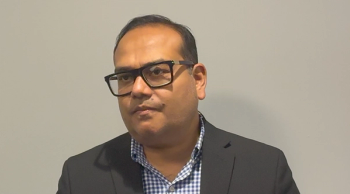
Oncology NEWS International
- Oncology NEWS International Vol 15 No 12
- Volume 15
- Issue 12
Still No Risk Group Found That Can Avoid RT After Lumpectomy
After 8 years' follow-up, tamoxifen plus breast radiation resulted in a lower rate of ipsilateral breast relapse than tamoxifen alone in women over 50 with early-stage, node-negative breast cancer treated initially with lumpectomy
PHILADELPHIAAfter 8 years' follow-up, tamoxifen plus breast radiation resulted in a lower rate of ipsilateral breast relapse than tamoxifen alone in women over 50 with early-stage, node-negative breast cancer treated initially with lumpectomy. Anthony W. Fyles, MD, of Princess Margaret Hospital and the University of Toronto, reported the results at the American Society for Therapeutic Radiology and Oncology (ASTRO) 48th Annual Meeting (abstract 8).
This analysis, an update of previous results from a randomized trial conducted at two Canadian centers, reflects investigators' continuing search for a category of women at sufficiently low risk for breast cancer recurrence that they might avoid radiation therapy.
Dr. Fyles compared his results to those of four other clinical trials of radiation added to tamoxifen that have failed to clearly define such a low-risk group. An unplanned subgroup analysis of the Canadian trial suggests "if one were to select patients who might be treated with hormones alone, we should include only those with tumors 1 cm or less and age 60 or above," he said. Even to make a recommendation in that group, "confirmatory results would be necessary."
The Canadian study, conducted at Princess Margaret Hospital and the British Columbia Cancer Agency, Vancouver, included 769 women with stage 0 or I, node-negative breast cancer. After lumpectomy and axillary dissection, all patients received standard-dose tamoxifen (20 mg/d for 5 years), and half, by random assignment, underwent breast radiation. According to the previously reported 5-year results, local recurrence was documented in 0.6% of women who received radiation/tamoxifen vs 7.7% of women who received tamoxifen alone (P < .001).
These initial results paralleled several other clinical trials of similar design, but with different entry criteria. Overall relapse rates showed striking differences among the studies, suggesting it might be possible to identify a group of low-risk patients who could forgo breast irradiation. The updated analysis was conducted in part to identify such a risk group, which was prospectively defined as patients with "a breast relapse rate of 5% or less at 8 years. Many of these relapses would be salvageable, and they would have little impact on overall survival," Dr. Fyles said.
In the Canadian study, overall outcomes at 8 years still favored radiation therapy, with a 12.2% incidence of ipsilateral breast relapse in the tamoxifen-only arm and a 4.1% rate in the radiotherapy plus tamoxifen group (P < .0001).
Results in subgroups from this study were analyzed and compared with previously published results from the CALGB (Cancer and Leukemia Group B) trial C9343 (N Engl J Med 351:971-977, 2004). Women in the CALGB study were age 70 or older and had tumors 2 cm or less in size that were node-negative and estrogen-receptor (ER) positive. These patients experienced a 1% 8-year relapse rate with tamoxifen plus radiation and a 4% rate with tamoxifen alone (P < .001).
In an analysis of a subgroup from the Canadian study that attempted to replicate the CALGB entry criteria (except that women were age 60 and older), Dr. Fyles and his co-workers found 8-year relapse rates of 6.5% with tamoxifen alone and 3.5% with combined therapystill too high to meet their definition of a low-risk group. "Only when we look at tumors 1 cm or less in women age 60 and older do we just manage to achieve our target of 5%," Dr. Fyles said. In these women, 8-year local relapse rates were 4.8% with tamoxifen alone and 4.2% with tamoxifen plus radiation.
Overall, the study results indicate that most women with node-negative, early-stage breast cancer who receive radiation therapy added to tamoxifen continue to benefit from it long-term, he said.
Vantage Point
Could Elderly Avoid Radiation Therapy?
ALPHONSE TAGHIAN, MD "We can safely say, based on several trials, that mastectomy is equivalent to lumpectomy plus radiation. The question now is, can tamoxifen substitute for radiation following conservative treatment," said Dr. Taghian, of Massachusetts General Hospital and Harvard Medical School, Boston. Although Dr. Fyles' analysis of the five studies indicates the answer is no, he said, tamoxifen alone does have some appeal in older women with serious comorbid illnesses.
"It is very important to remember that in both treatment arms of the CALGB study, 25% of the patients died from other diseases and only 2% from breast cancer," Dr. Taghian commented.
Hormonal therapy without radiation therapy has less appeal in healthy older patients with an anticipated life expectancy of 10 or 15 years, he said. "At present, most oncologists would treat these women with an aromatase inhibitor rather than tamoxifen," he said.
For the future, he said, if 1 week of partial breast irradiation is found to have equivalent efficacy to the current 6-week whole-breast schedule, "this more convenient and less toxic option might be particularly useful in older patients."
Articles in this issue
almost 19 years ago
Best Rx Most Cost-Effective: RTOGalmost 19 years ago
Grape Seed Found to Be a Natural Aromatase Inhibitoralmost 19 years ago
Drug Combination Prevents ER-Negative Tumors in Micealmost 19 years ago
Democrats' Agenda May Stifle Efforts for More Ca Fundingalmost 19 years ago
No Loss of Efficacy With Synchronous Chemotherapy/ESPalmost 19 years ago
'Share Care' Difficult for Ca Survivors and Their Oncologistsalmost 19 years ago
Biomarkers Panel Promising for Detecting Pancreatic Caalmost 19 years ago
Preop Avastin/Tarceva in RCCalmost 19 years ago
Reovirus Agent Shows Activity in Phase I TrialNewsletter
Stay up to date on recent advances in the multidisciplinary approach to cancer.




















































































